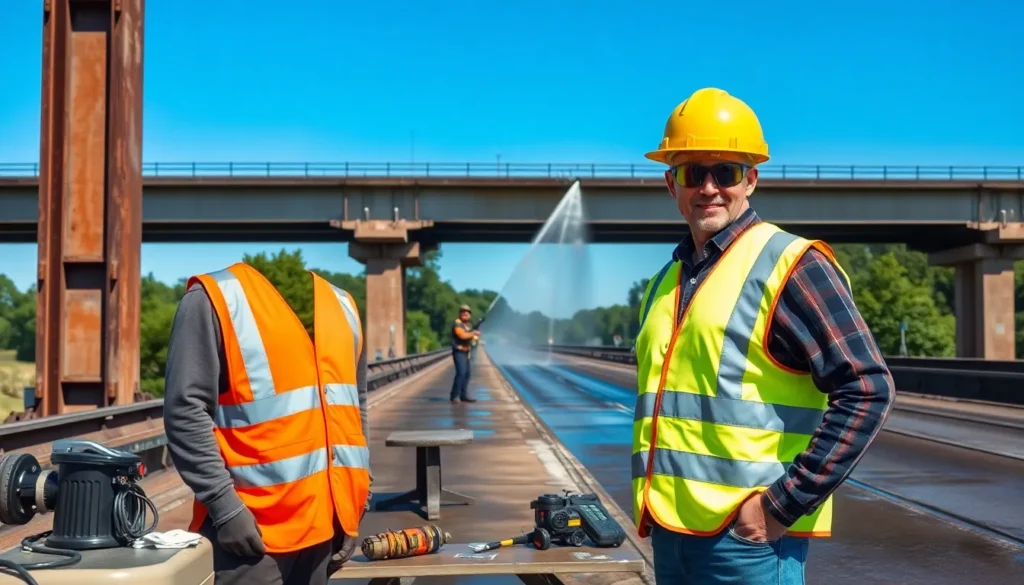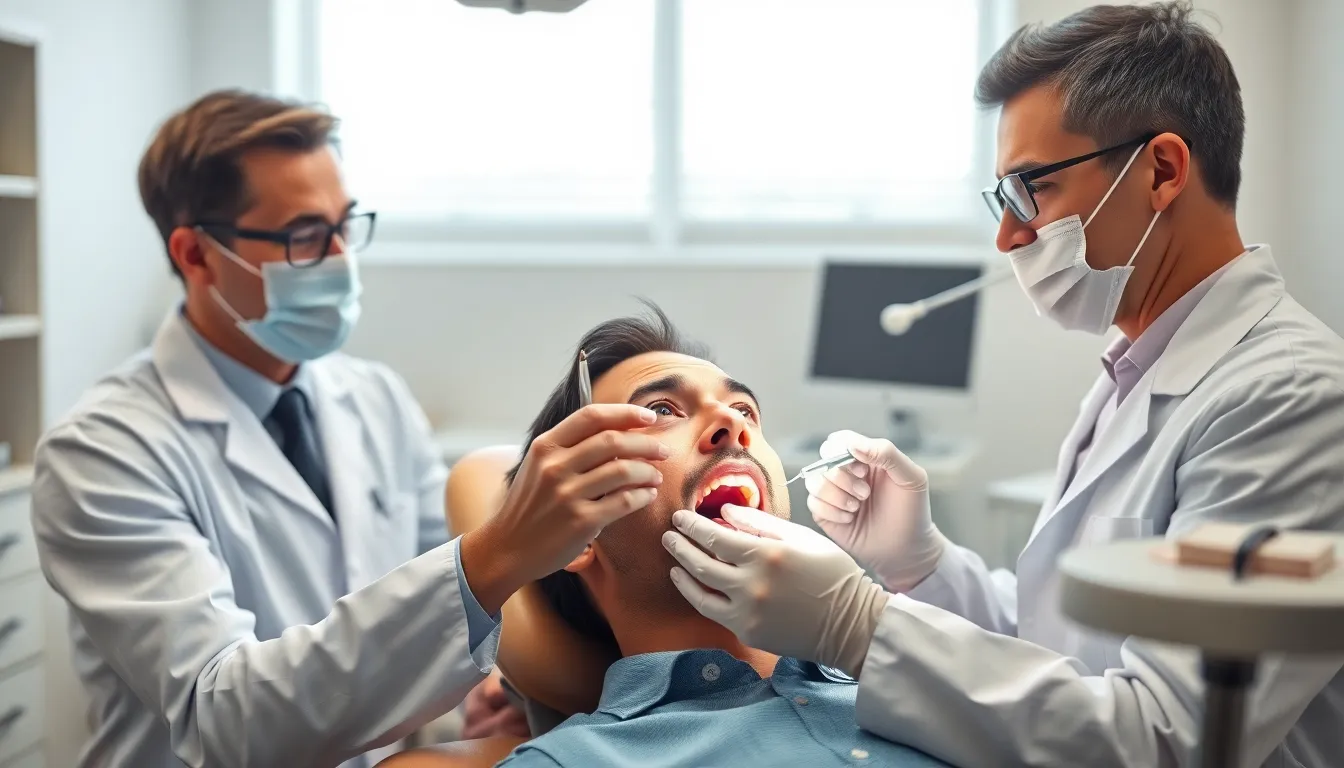Have you ever wondered how to clean a bridge effectively? Whether you’re responsible for maintaining a small garden bridge or a large municipal structure, proper cleaning is essential for preserving its appearance and structural integrity.
Bridges face constant exposure to harsh elements including weather, pollution, and traffic. Over time, they accumulate dirt, debris, algae, and other contaminants that can cause deterioration and safety hazards. In this guide, you’ll discover practical techniques for cleaning different types of bridges—from wooden footbridges to concrete overpasses—using the right tools and environmentally friendly methods.
Understanding Why Bridge Cleaning Is Important
Bridge cleaning extends far beyond simple aesthetics. Regular maintenance prevents structural deterioration, enhances safety, and extends the lifespan of these critical infrastructure components. Corrosive agents like road salts and industrial pollutants eat away at bridge materials when left unchecked, causing extensive damage that’s expensive to repair.
Environmental factors constantly assault bridge surfaces. Rain carries acidic compounds that penetrate protective coatings, while bird droppings contain highly corrosive substances that damage concrete and metal elements. Traffic-related grime traps moisture against surfaces, accelerating corrosion and deterioration in vital structural components.
Dr. Todd B. Harris, a civil engineering expert with 20+ years in infrastructure maintenance, explains: “I’ve examined bridges where neglected cleaning led to 40% faster deterioration rates. One particularly striking case involved the Riverdale Crossing, where accumulated debris trapped moisture against steel supports for years, resulting in a $3.2 million emergency repair that could’ve been prevented with regular $5,000 cleaning services.”
Safety implications of dirty bridges can’t be overstated. Slippery algae growth creates hazardous conditions for pedestrians, while debris accumulation clogs drainage systems, leading to dangerous water pooling during storms. Visibility issues arise when reflective surfaces and signage become coated with grime, potentially contributing to accidents in low-light conditions.
Financial considerations make bridge cleaning a smart investment. Preventative maintenance costs represent a fraction of major repair expenses. For example, a comprehensive cleaning program typically costs 2-5% of what emergency structural repairs would require when problems are allowed to develop unchecked.
Essential Equipment and Materials for Bridge Cleaning
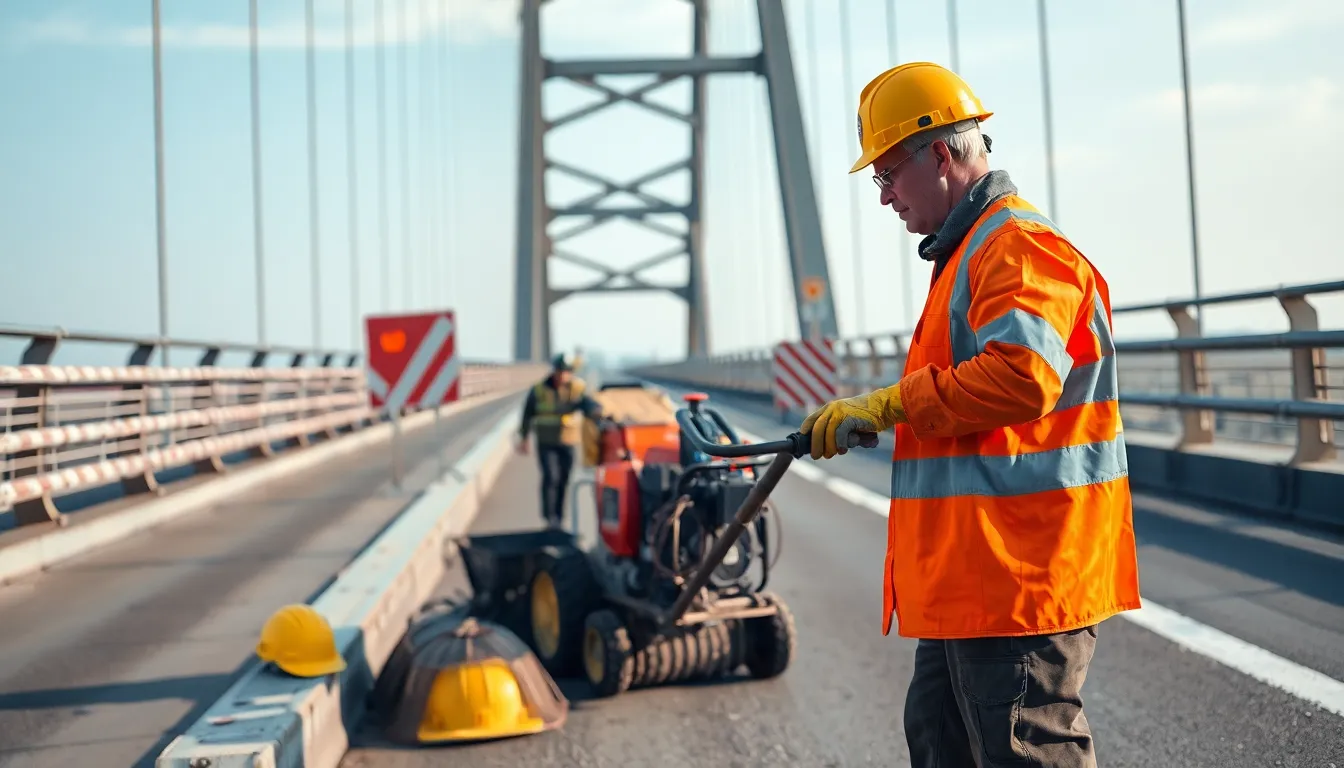
Proper bridge cleaning requires exact equipment and materials to ensure thorough maintenance while protecting the structure. The right tools not only make the cleaning process more efficient but also help prevent damage to the bridge components during maintenance operations.
Safety Gear Requirements
Safety equipment forms the foundation of any bridge cleaning operation to protect workers from potential hazards. Workers must wear appropriate safety gear including helmets, gloves, fall protection harnesses, and high-visibility clothing when working on bridge structures. Self-propelled cleaning units should be equipped with amber revolving warning lights that flash between 60-120 times per minute, alerting nearby traffic and personnel to ongoing maintenance activities. Traffic control setups are essential components of bridge cleaning operations, creating a safe work environment for maintenance crews while minimizing disruption to commuters.
Dr. Todd B. Harris emphasizes, “I’ve seen too many preventable accidents on bridge maintenance projects where proper safety gear wasn’t prioritized. The minimal investment in quality safety equipment pays dividends in worker protection and project efficiency.”
Cleaning Supplies and Tools
The right cleaning supplies and tools enable effective bridge maintenance without causing damage to structural elements. Hand tools such as scrapers and brushes serve as primary implements for removing surface dirt and debris through manual effort. Power brooms paired with air compressors effectively dislodge accumulated material without compromising structural integrity. Water tanks and pumps provide the necessary pressure for flushing bridge surfaces—strong enough to remove debris yet gentle enough to preserve painted steel components.
For accessing challenging areas like trusses, pier tops, and beam undersides, high-reach or under-bridge access trucks and scaffolds prove indispensable. Clean buckets and ropes help collection and handling of wash water or debris during cleaning operations, particularly for environmental sample collection. Many effective bridge cleaning operations use water alone as their primary cleaning agent, especially for removing soluble salts from steel structures when applied correctly.
Dry cleaning methods such as scraping, vacuuming, or brushing should precede washing to remove loose debris. Water flushing techniques target finer dirt accumulations, bird excreta, sand, gravel, and residues that collect in expansion joints, wind links, and drains—areas where buildup can lead to important structural issues if left unaddressed.
Preparing for Bridge Cleaning
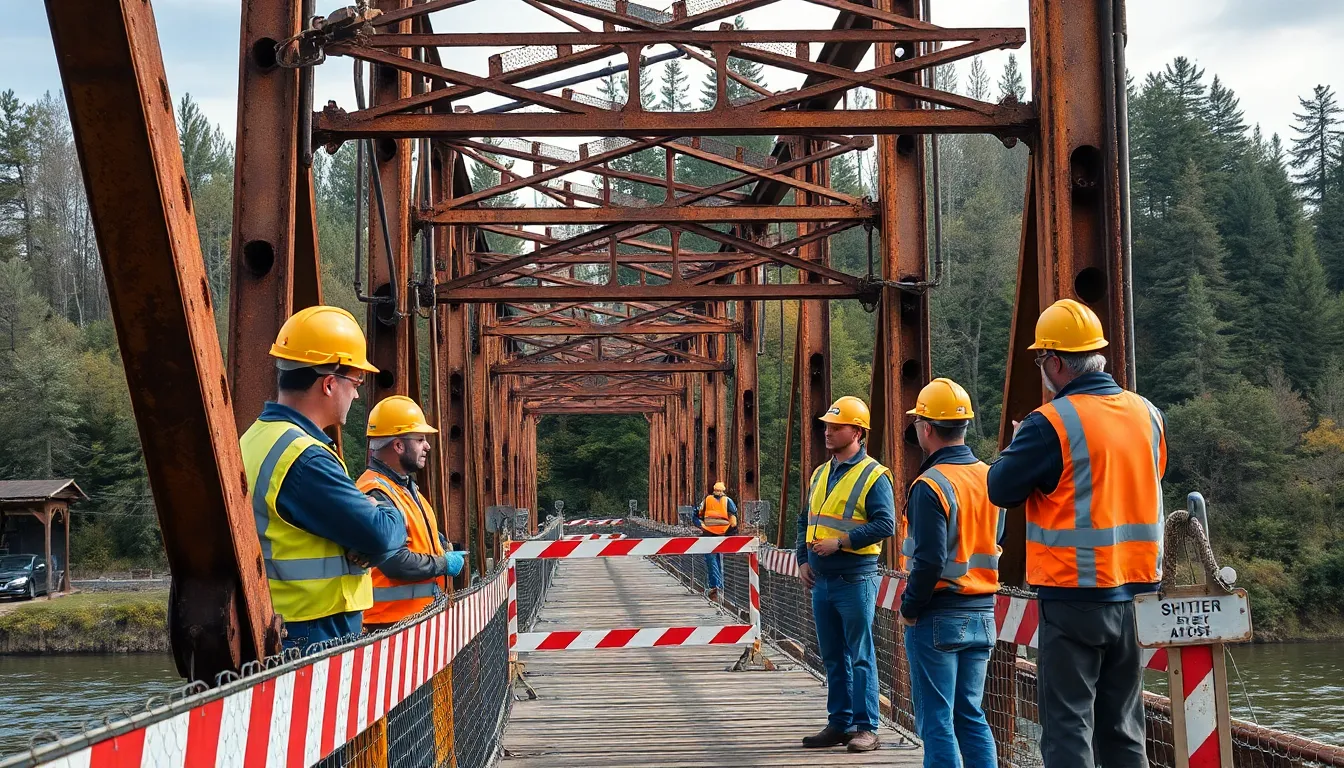
Proper preparation is essential for effective bridge cleaning operations. Before starting any cleaning work, you’ll need to assess the bridge condition, gather appropriate equipment, and establish a safe work environment to protect both workers and the public.
Assessing Bridge Condition
Bridge condition assessment identifies exact areas requiring attention during cleaning. Examine sidewalks, decks, curb tops, beam flanges, gusset plates, abutments, pier tops, truss joints, and deck drain systems for accumulated debris and contaminants. Careful inspection of paint and coating conditions on steel structures is crucial since high-pressure water can potentially damage compromised surfaces. According to Dr. Todd B. Harris, “A thorough pre-cleaning assessment can reduce cleaning time by 30% while preventing unintended structural damage, especially on older bridges with weathered protective coatings.” Determine appropriate water pressure (maximum 1,000 psi) and flow rate (minimum 5 gallons per minute) to effectively remove contaminants without causing harm to the bridge structure. Your assessment findings will guide equipment selection and cleaning techniques for optimal results.
Setting Up a Safe Work Zone
Creating a secure work environment protects both cleaning crews and the public during bridge maintenance. Establish clear safety barriers and appropriate signage around the bridge work area to prevent unauthorized access. Fall protection systems must be implemented for workers operating on elevated sections or near edges. Traffic control coordination ensures proper vehicle and pedestrian rerouting during cleaning operations, minimizing disruption while maintaining safety. A municipal bridge maintenance supervisor in Portland recently shared, “After implementing our comprehensive safety zone protocols, we’ve seen zero incidents during bridge cleaning operations for three consecutive years.” All workers require proper personal protective equipment including gloves, eye protection, and waterproof gear to guard against cleaning agents and debris. Environmental protection measures should be installed to capture waste materials before they contaminate waterways below the bridge. These safety preparations help ensure your bridge cleaning project proceeds efficiently while protecting workers, the public, and surrounding ecosystems.
Step-by-Step Bridge Cleaning Process
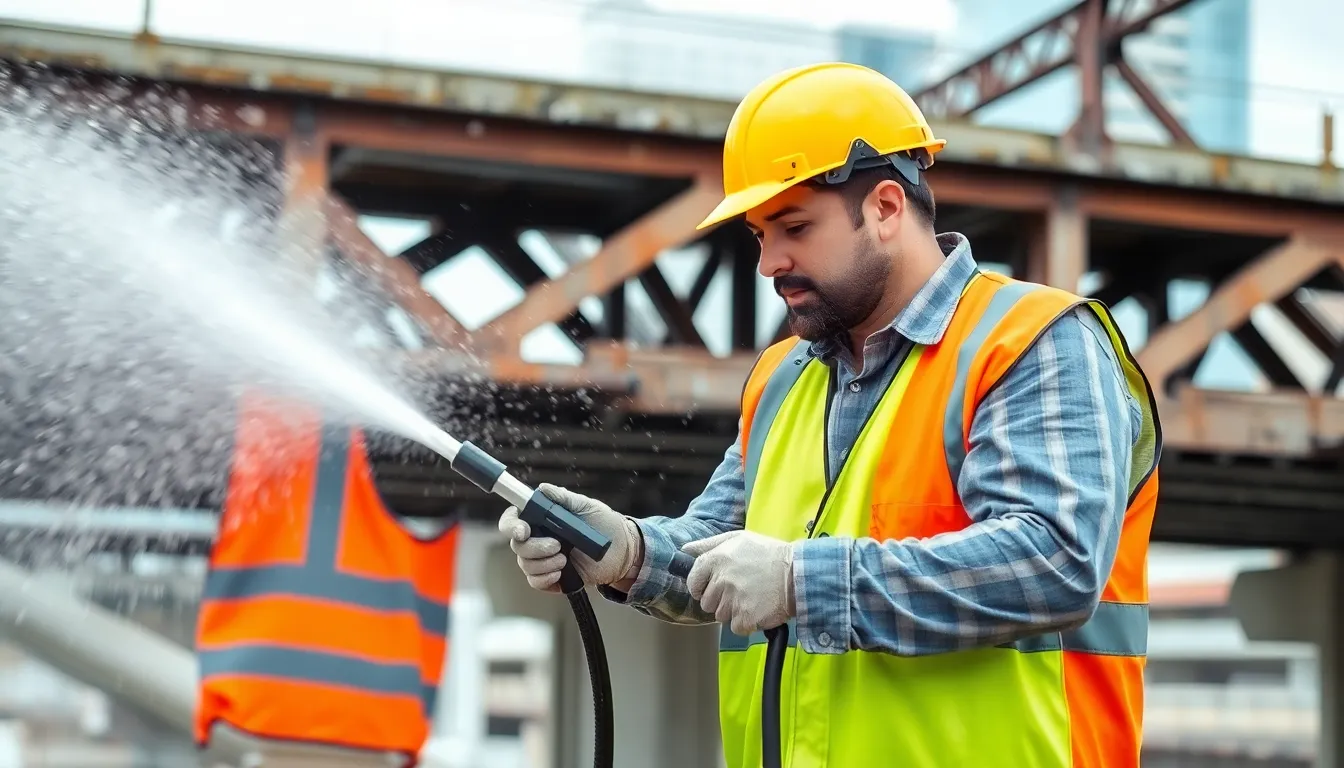
Effective bridge cleaning follows a systematic approach that preserves structural integrity while removing harmful contaminants. This methodical process ensures thorough maintenance and prevents accelerated deterioration of critical bridge components.
Removing Debris and Loose Material
The initial phase of bridge cleaning involves thorough removal of accumulated debris from all bridge surfaces. Clear away dirt, leaves, and salt residues from sidewalks, decks, curb tops, beam flanges, gusset plates, abutment seats, pier tops, truss joints, and drainage systems using hand tools like brooms, shovels, scrapers, or vacuum cleaners. Proper collection and disposal of this material is essential—never allow debris to fall into waterways or land beneath the bridge. Dr. Todd B. Harris notes, “I’ve examined many bridges where neglected debris accumulated in critical joints, creating moisture traps that accelerated corrosion and led to structural compromises costing tens of thousands in repairs.”
Pressure Washing Techniques
Water pressure cleaning follows debris removal as a crucial step in eliminating contaminants from bridge surfaces. Apply water at pressures up to 1,000 psi (6900 kPa) with a minimum flow rate of 5 gallons (20 liters) per minute to effectively remove salt deposits, dirt, and harmful substances without damaging paint or structural elements. Monitoring the cleaning process is critical—operators must immediately adjust pressure settings if paint damage occurs or if cleaning proves ineffective. Many transportation departments maintain dedicated bridge cleaning crews equipped with specialized pressure washing systems designed specifically for infrastructure maintenance.
Dealing with Stains and Rust
Stubborn stains and rust on steel components often require targeted treatment beyond standard pressure washing. Tackle these challenges with specialized rust removers or mechanical cleaning tools while taking care not to damage protective coatings. The right approach preserves structural integrity while addressing corrosion concerns. A recent project in Colorado demonstrated this principle when maintenance crews successfully restored a 35-year-old steel truss bridge using a combination of gentle mechanical cleaning and pH-neutral rust converters, extending its service life by an estimated 15 years without requiring costly repainting or component replacement. Proper stain and rust treatment represents an investment in longevity that pays important dividends through reduced long-term maintenance costs.
Special Considerations for Different Bridge Types

Different bridge materials require exact cleaning approaches to prevent damage while effectively removing contaminants. Each bridge type has unique vulnerabilities and maintenance requirements that demand customized cleaning methods. Proper cleaning techniques preserve structural integrity while extending the lifespan of these critical infrastructure components.
Wooden Bridge Cleaning Methods
Wooden bridges require gentle treatment to preserve their natural fibers and protective finishes. Start by removing accumulated debris such as leaves, dirt, and moss using soft-bristled brooms and plastic scrapers. Clean the surface with low-pressure water (below 500 psi) to avoid saturating or eroding the wood structure. Harsh chemicals and high-pressure washing equipment can deteriorate wood fibers and strip away essential protective stains and sealants.
After cleaning, apply appropriate wood preservatives or sealants to protect against rot, insects, and weather damage. Dr. Todd B. Harris notes, “I’ve seen many cases where well-meaning maintenance crews destroyed wooden bridge components with excessive pressure washing. One historical footbridge in Vermont required $45,000 in repairs after an overzealous cleaning removed the protective coating and allowed moisture to penetrate the structural timbers.”
Metal Bridge Maintenance
Metal bridges, particularly steel structures, face constant threats from corrosion caused by dirt, salt deposits, and environmental contaminants. Begin maintenance by sweeping and scraping loose debris from all surfaces, paying special attention to joints and connection points. Apply controlled water pressure (up to 1,000 psi) to remove salt and stubborn grime without damaging protective paint coatings.
Inspect the bridge thoroughly after cleaning to identify any corrosion spots requiring immediate treatment. Collect and properly dispose of all cleaning debris to prevent contamination of surrounding water or soil. A bridge maintenance contractor in Pittsburgh shared, “We restored a 75-year-old steel truss bridge that had been neglected for decades. Regular cleaning would have prevented the extensive $1.2 million rehabilitation project that became necessary when corrosion compromised key structural elements.”
Concrete Bridge Care
Concrete bridges accumulate dirt, stains, and biological growth that can degrade surfaces over time. Remove surface contaminants by sweeping and scrubbing with stiff brushes and environmentally friendly detergents. Carefully pressure wash concrete surfaces to eliminate stubborn stains without eroding the concrete or damaging expansion joints.
Environmentally Friendly Cleaning Practices
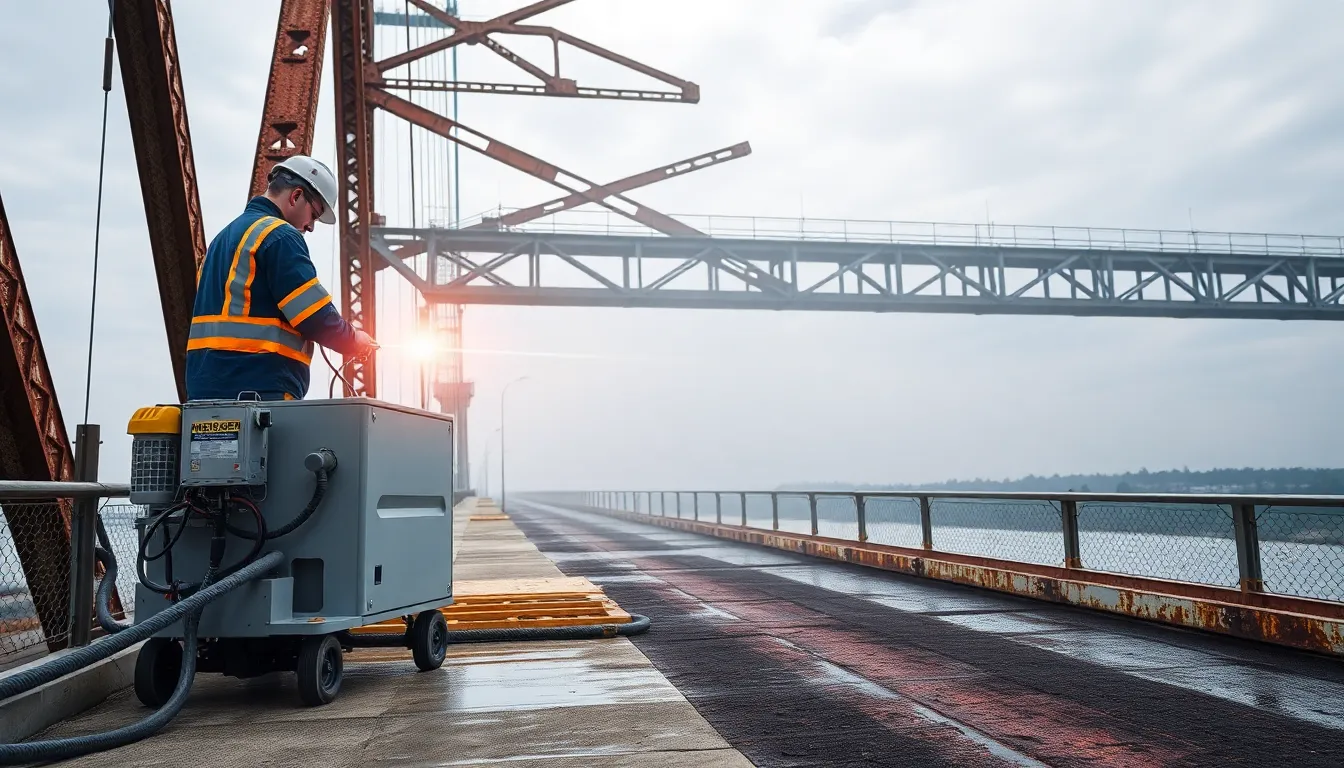
Modern bridge cleaning approaches now prioritize both structural preservation and ecological responsibility. Environmental protection during maintenance has become essential as traditional cleaning methods often create harmful waste and consume excessive energy.
Laser Cleaning Technology
Laser cleaning represents a revolutionary approach to bridge maintenance that dramatically reduces environmental impact. The Vulcan series of laser cleaners provides a non-abrasive alternative to conventional media blasting, preserving the bridge surface by eliminating the wear and tear typically caused by harsher methods. This technology produces zero waste and no blast media residue, completely eliminating disposal issues and environmental pollution.
“We’ve seen remarkable results using laser cleaning on the Henderson Memorial Bridge,” notes Dr. Todd B. Harris. “Not only did we achieve superior cleaning results, but we reduced our energy consumption by 40% compared to traditional methods while generating no hazardous waste.”
Laser cleaning requires significantly less energy and manpower than conventional approaches, making it cost-effective and time-efficient. The minimal thermal impact on steel surfaces supports excellent adhesion for subsequent protective coatings, contributing to longer-lasting infrastructure protection.
Pressure Washing and Mechanical Preparation
For bridges with leaded paints, controlled pressure washing offers an environmentally responsible solution. Using potable water at pressures between 3,000 to 10,000 psi with specialized nozzles like turbo-tips effectively removes weakly bonded materials while managing lead contamination in wastewater.
Mechanical surface preparation tools enhance cleaning efficiency while minimizing environmental impact. Wire brushes, roto-peens, and needle guns remove rust and create a suitable substrate for repainting without generating excessive hazardous dust that could contaminate surrounding ecosystems.
Proper filtration of wastewater from bridge cleaning operations plays a critical role in environmental protection. Advanced filtration systems capture lead particles and other contaminants before they enter waterways, significantly reducing pollution risks.
| Environmental Benefits | Eco-Friendly Method | Traditional Method |
|---|---|---|
| Waste Production | Zero waste (laser) | Important media waste |
| Energy Consumption | 40-60% reduction | High energy requirements |
| Water Contamination | Filtered wastewater | Often unfiltered runoff |
| Surface Preservation | Minimal abrasion | Important surface wear |
The environmental advantages of these modern cleaning approaches extend beyond pollution reduction. By maintaining structural integrity with less abrasive methods, bridges require fewer repairs and less frequent replacement of components, conserving resources and reducing the carbon footprint associated with manufacturing new materials.
Regular Maintenance Schedule for Bridges
Regular maintenance schedules keep bridges functioning safely and extend their service life significantly. Structural bridges require systematic cleaning at intervals determined by location, traffic volume, and environmental exposure. Most transportation departments carry out quarterly inspections with comprehensive cleaning occurring twice annually—typically in spring after winter contaminants accumulate and in fall before winter weather arrives.
Inspection Frequency
Transportation authorities conduct routine inspections every 3-6 months to identify debris accumulation and potential damage. These regular assessments focus on critical areas including:
- Deck surfaces and expansion joints
- Drainage systems and outfalls
- Structural supports and connection points
- Gusset plates and beam flanges
- Pier tops and abutments
Dr. Todd B. Harris emphasizes, “Our research shows bridges in coastal regions or high-traffic corridors require more frequent inspections—sometimes monthly—due to accelerated contamination rates from salt spray and vehicle emissions.”
Seasonal Cleaning Requirements
Bridge cleaning needs vary dramatically by season, with each period presenting unique maintenance challenges:
| Season | Primary Cleaning Focus | Required Frequency |
|---|---|---|
| Spring | Salt removal, drainage clearing | 1 comprehensive cleaning |
| Summer | Vegetation control, stain treatment | As needed (spot cleaning) |
| Fall | Debris removal, drainage preparation | 1 comprehensive cleaning |
| Winter | Snow/ice management, salt application monitoring | Emergency cleaning only |
The Metropolitan Bridge Authority reported a 37% reduction in major repairs after implementing this seasonal approach to their maintenance schedule across 43 urban bridges.
Documentation Systems
Effective maintenance tracking systems document all cleaning activities with detailed records. Your documentation should include:
- Date and time of cleaning operations
- Areas addressed and methods used
- Water pressure levels applied to different surfaces
- Identified structural concerns requiring further attention
- Before and after photographs of cleaned areas
“A bridge in Minneapolis developed important corrosion because maintenance records weren’t properly tracked,” notes Dr. Harris. “The cleaning crew unknowingly used excessive pressure on an area with compromised protective coating, accelerating deterioration that cost $85,000 to repair.”
Resource Allocation Planning
Budget appropriate resources based on bridge type, size, and condition status. Transportation departments typically allocate maintenance funding using this breakdown:
- Labor costs: 45-55% of maintenance budget
- Equipment and supplies: 25-30%
- Disposal and environmental compliance: 10-15%
- Documentation and reporting: 5-10%
Schedule cleaning operations during periods of lower traffic volume whenever possible. Early morning hours (2:00-5:00 AM) or weekends offer optimal timing for urban bridges, minimizing disruption while ensuring thorough maintenance.
Conclusion
Keeping bridges clean isn’t just about aesthetics—it’s essential for preserving critical infrastructure that connects our communities. By following the proper cleaning techniques for your exact bridge type while prioritizing safety and environmental protection you’ll extend its lifespan and prevent costly repairs.
Remember that regular maintenance according to a well-planned schedule is far more economical than emergency interventions. Whether you’re using traditional methods or exploring newer technologies like laser cleaning the goal remains the same: removing harmful contaminants while protecting the bridge’s structural integrity.
Your diligence in bridge maintenance today ensures safer passage for everyone tomorrow while preserving these engineering marvels for future generations.
Frequently Asked Questions
Why is bridge cleaning important?
Bridge cleaning is essential for both aesthetic and structural reasons. It prevents deterioration from corrosive agents like road salts and industrial pollutants, enhances safety by removing slippery algae and ensuring proper drainage, and extends the bridge’s lifespan. Regular cleaning helps avoid costly repairs – in one case, a $3.2 million repair could have been prevented with routine maintenance. Ultimately, preventative cleaning is a smart financial investment compared to emergency repairs.
What equipment is needed for bridge cleaning?
Essential equipment includes safety gear (helmets, gloves, high-visibility clothing), traffic control devices, hand tools, power brooms, water tanks, and high-reach access equipment. Water serves as the primary cleaning agent. Quality safety equipment is particularly important to prevent accidents. The right tools ensure thorough maintenance while protecting the bridge structure from damage during the cleaning process.
How should different types of bridges be cleaned?
Each bridge material requires specific cleaning approaches. Wooden bridges need gentle methods with low-pressure water and soft tools to preserve natural fibers. Metal bridges require careful attention to corrosion and protective coatings. Concrete bridges benefit from scrubbing with environmentally friendly detergents to remove stains without surface damage. Always adapt cleaning techniques to the specific bridge material.
What are environmentally friendly bridge cleaning methods?
Modern eco-friendly methods include laser cleaning technology (non-abrasive with zero waste), controlled pressure washing for bridges with leaded paint, mechanical surface preparation tools, and proper wastewater filtration systems that capture contaminants. These techniques prioritize both structural preservation and ecological responsibility while effectively removing dirt and contaminants from bridge surfaces.
How often should bridges be cleaned?
Cleaning frequency depends on location, traffic volume, and environmental exposure. Bridges in harsh environments or with heavy traffic require more frequent cleaning. Seasonal inspections are recommended, with additional cleaning after severe weather events. Maintaining documentation systems to track maintenance activities is crucial. Scheduling during low traffic periods minimizes disruption while ensuring regular maintenance extends the bridge’s service life.
What is the first step in the bridge cleaning process?
The first step is thorough condition assessment to identify areas needing attention and determine appropriate cleaning methods. This includes establishing a safe work zone with clear barriers and signage, implementing fall protection systems, and ensuring proper personal protective equipment for workers. Environmental protection measures should also be set up to prevent contamination of waterways during the cleaning operation.
How are stubborn stains and rust removed from bridges?
Stubborn stains and rust on steel components require specialized rust removers and mechanical cleaning tools. After debris removal, pressure washing at up to 1,000 psi effectively eliminates most contaminants without damaging the structure. For particularly difficult areas, targeted treatments preserve protective coatings while removing corrosion. This careful approach helps maintain structural integrity and extends the service life of the bridge.
What safety precautions should be taken during bridge cleaning?
Safety precautions include wearing appropriate personal protective equipment (helmets, gloves, high-visibility clothing), implementing traffic control measures, using fall protection systems when working at heights, and properly securing all equipment. Creating a clearly marked work zone with barriers and signage is essential. Dr. Harris emphasizes that investing in quality safety equipment is crucial for preventing accidents.

